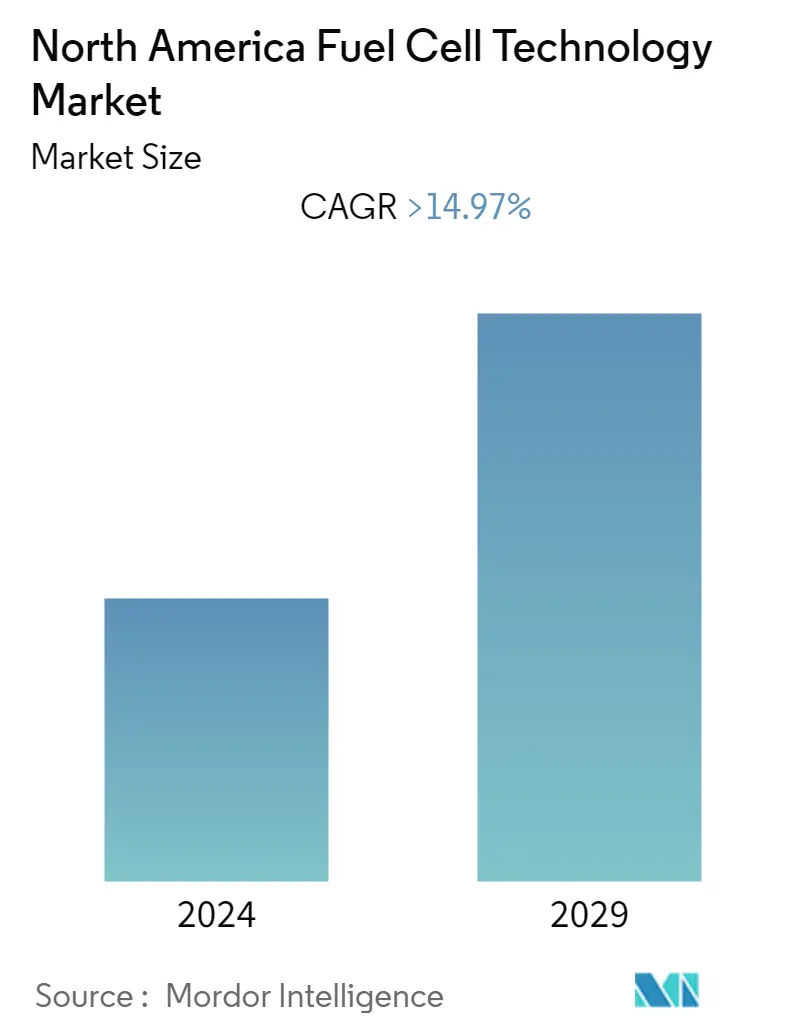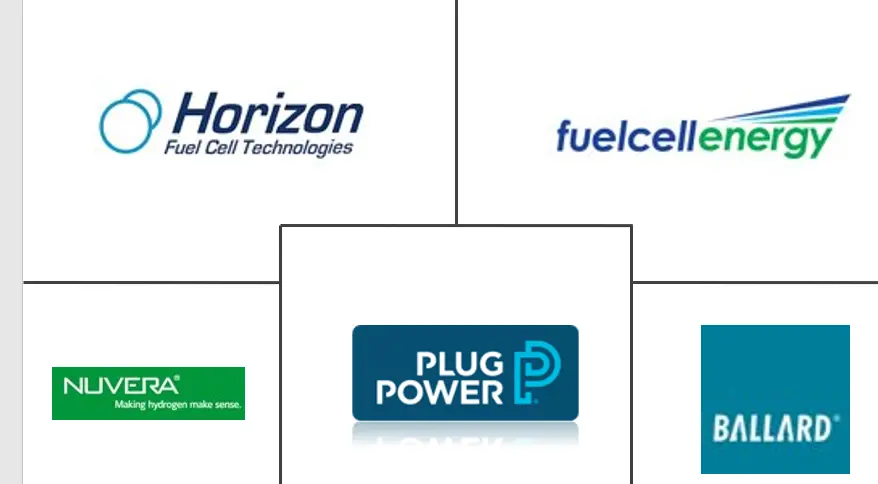Market Size of North America Fuel Cell Technology Industry

| Study Period | 2021 - 2029 |
| Base Year For Estimation | 2023 |
| Forecast Data Period | 2024 - 2029 |
| Historical Data Period | 2021 - 2022 |
| CAGR | > 14.97 % |
| Market Concentration | Low |
Major Players
*Disclaimer: Major Players sorted in no particular order |
North America Fuel Cell Technology Market Analysis
The North American fuel cell technology market is expected to register a CAGR of 14.97% during the forecast period.
The market was negatively impacted by COVID-19 in 2020. Currently. The market has reached pre-pandemic levels.
- Over the long term, the advantages of fuel cells over their alternatives, such as lithium-ion batteries, government initiatives, and private investment support, are expected to drive the market studied.
- On the other hand, the availability of proven and cost-effective alternate energy storage systems and the lack of hydrogen supply infrastructure are expected to restrain the market during the forecast period.
- Nevertheless, pure battery vehicles cannot cover all the route, load, and refueling requirements; therefore, fuel cells are a practical solution for trucks to maintain a place. Thus, this is expected to provide an excellent opportunity for the fuel cell technology market in the near future.
North America Fuel Cell Technology Industry Segmentation
Fuel cells use the chemical energy of hydrogen to produce electricity efficiently. They need not be periodically recharged like batteries. Instead, they continue to generate electricity as long as a fuel source is provided. Fuel cells are very clean, with the only by-products being electricity, excess heat, and water.
The North American fuel cell market is segmented by application, fuel cell technology, and geography. By application, the market is segmented into portable, stationary, and transportation. By fuel cell technology, the market is segmented into polymer electrolyte membrane fuel cells (PEMFC), solid oxide fuel cells (SOFC), and other fuel cell technologies. The report also covers the market size and forecasts for the fuel cell market in major countries across the region. For each segment, the market sizing and forecasts have been done based on revenue (USD billion).
| Application | |
| Portable | |
| Stationary | |
| Transportation |
| Fuel Cell Technology | |
| Polymer Electrolyte Membrane Fuel Cell (PEMFC) | |
| Solid Oxide Fuel Cell (SOFC) | |
| Other Fuel Cell Technologies |
| Geography | |
| United States | |
| Canada | |
| Rest of North America |
North America Fuel Cell Technology Market Size Summary
The North American fuel cell technology market is poised for significant growth, driven by the advantages of fuel cells over alternatives like lithium-ion batteries, alongside supportive government initiatives and private investments. Despite challenges such as the availability of cost-effective energy storage systems and insufficient hydrogen supply infrastructure, the market is expected to thrive. Fuel cells offer practical solutions for transportation needs, particularly in trucks, where pure battery vehicles may not suffice. The region, especially the United States, has been a pioneer in adopting polymer electrolyte membrane (PEM)-based fuel cells, supported by government funding and increasing demand from the automotive sector. Initiatives like California's Alternative and Renewable Fuel and Vehicle Technology Program have spurred private sector investments, further bolstering market growth.
The United States leads in the deployment of fuel cell electric vehicles (FCEVs) and stationary power systems, with California at the forefront due to its Zero Emission Vehicle Program. PEM technology remains dominant in the transportation sector, with major automotive companies like Toyota and Hyundai investing in reducing production costs. Collaborative efforts between government and industry are expected to enhance the adoption of fuel cells, particularly in the transportation sector, where a significant portion of deployed systems is concentrated. The market is characterized by fragmentation, with key players such as Ballard Power Systems Inc., Horizon Fuel Cell Technologies Pte Ltd, and others driving innovation and expansion. Recent developments, including Loop Energy's efficiency gains and Bosch's investment in U.S. production, highlight the ongoing commitment to advancing fuel cell technology in the region.
North America Fuel Cell Technology Market Size - Table of Contents
-
1. MARKET OVERVIEW
-
1.1 Introduction
-
1.2 Market Size and Demand Forecast in USD billion, till 2027
-
1.3 Recent Trends and Developments
-
1.4 Government Policies and Regulations
-
1.5 Market Dynamics
-
1.5.1 Drivers
-
1.5.2 Restraints
-
-
1.6 Supply Chain Analysis
-
1.7 Porter's Five Forces Analysis
-
1.7.1 Bargaining Power of Suppliers
-
1.7.2 Bargaining Power of Consumers
-
1.7.3 Threat of New Entrants
-
1.7.4 Threat of Substitutes Products and Services
-
1.7.5 Intensity of Competitive Rivalry
-
-
-
2. MARKET SEGMENTATION
-
2.1 Application
-
2.1.1 Portable
-
2.1.2 Stationary
-
2.1.3 Transportation
-
-
2.2 Fuel Cell Technology
-
2.2.1 Polymer Electrolyte Membrane Fuel Cell (PEMFC)
-
2.2.2 Solid Oxide Fuel Cell (SOFC)
-
2.2.3 Other Fuel Cell Technologies
-
-
2.3 Geography
-
2.3.1 United States
-
2.3.2 Canada
-
2.3.3 Rest of North America
-
-
North America Fuel Cell Technology Market Size FAQs
What is the current North America Fuel Cell Technology Market size?
The North America Fuel Cell Technology Market is projected to register a CAGR of greater than 14.97% during the forecast period (2024-2029)
Who are the key players in North America Fuel Cell Technology Market?
Ballard Power Systems Inc., Horizon Fuel Cell Technologies Pte Ltd, FuelCell Energy Inc., Plug Power Inc. and Nuvera Fuel Cells LLC are the major companies operating in the North America Fuel Cell Technology Market.

